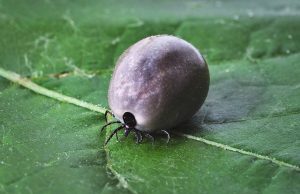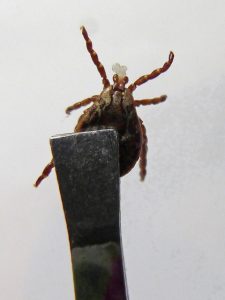In my last article I talked about ways to keep pests like mosquitoes and ticks from invading your yard and ruining outdoor outings. In this article I would like to focus on ticks and the dangers they present as well as what symptoms to look out for if you think you may have been exposed to a tick born disease.
 There are many different species of ticks throughout the world, but only a few bite and transmit diseases to humans.
There are many different species of ticks throughout the world, but only a few bite and transmit diseases to humans.
These are the species, and where they are most likely to be found:
The American Dog Tick: East of the Rocky Mountains, and limited areas along the California coast
The Brown Dog Tick: Worldwide
The Black Legged Tick: Northeast and Upper Midwest United States
The Western Black Legged Tick: Pacific Coast of United States particularly in northern California
The Gulf Coast Tick: Atlantic and Gulf Coast of the Unites States
The Lone Star Tick: South Eastern and Eastern United States
The Rocky Mountain Wood Tick: Rocky Mountain United States, Southwestern Canada
Most ticks have stages that they go through beginning as egg, larva, nymph and adult. Once they have come out of their eggs, ticks must feed on blood during each stage of their growth in order to survive.
While most ticks prefer to find a different kind of host for each stage of it’s growth they will attach themselves to any available host if necessary. Different kinds of ticks can sense body odors and body heat in addition to an animal’s breath, vibrations and even it’s shadows. They will position themselves along areas that get a lot of use and will rest on the tips of grass stems, shrubs or leaves.
Ticks cannot jump or fly at their prey, but they can hold onto the perch by their back legs while stretching out their front legs to grasp onto their host as it passes by. Some will find a place on their host and attach quickly while others will wander for a while looking for a spot like the ear where the skin is thinner and easier to pierce. This looking for the perfect place can take from 10 minutes to 2 hours depending on the tick.
 Once it has attached itself the tick will slowly feed for up to two days. If the host has a blood borne disease the tick will ingest it. Once the pathogen has gotten into the tick it can now pass it along to it’s next host.
Once it has attached itself the tick will slowly feed for up to two days. If the host has a blood borne disease the tick will ingest it. Once the pathogen has gotten into the tick it can now pass it along to it’s next host.
While Lyme Disease gets most of the attention there are numerous diseases that can be passed along through a tick bite, and people should be aware of what they are and how to spot the symptoms.
Tick disease transmission list:
The American Dog Tick may transmit:Tularemia and Rocky Mountain Spotted Fever.
The Brown Dog Tick may transmit: Rocky Mountain Spotted Fever
The Black Legged Tick may transmit: Lyme Disease, Anaplasmosis, Babesiosis, and Powassan Disease
The Western Black Legged Tick may transmit: Anaplasmosis, and Lyme Disease
The Gulf Coast Ticks may transmit: Rickettsia Parkeri Rickettsiosis which is a form of spotted fever.
The Lone Star Tick may transmit: Ehrlichosis, Tularemia, and STARI (southern tick-associated rash illness)
The Rocky Mountain Wood Tick may transmit: Rocky Mountain Spotted Fever, Colorado Tick Fever, Tularemia
The symptoms of Tularemia
Symptoms will depend on how the bacteria enters the body, and symptoms can range from mild to life-threatening. Each form of this disease will have a fever, which can be as high as 104 °F. but because this disease can have many varying symptoms I would recommend reading about them on the CDC’s website https://www.cdc.gov/tularemia/signssymptoms/index.html
Rocky Mountain Spotted Fever
Symptoms may include fever, headache, abdominal pain, vomiting, and muscle pain which usually appear within 1 to 2 weeks after being bitten.
Lyme Disease
Symptoms may include fever, headache, fatigue, and the characteristic Bulls Eye Rash seen usually 3 to 30 days after being bitten. Untreated Lyme disease can spread to the joints, heart and nervous system and can cause severe disabilities.
 Anaplasmosis
Anaplasmosis
Symptoms are fever, headaches, chills, and muscle aches occurring usually within 1 to 2 weeks of the bite.
Babseosis
Many times this does not have discernible symptoms though some people do develop nonspecific flu like symptoms such as fever, chills, body aches, headaches etc. If you have been bitten by a tick and experience these symptoms see your doctor to have a blood sample examined.
Powassan Disease
This disease is rare, only about 75 cases were reported in the United States in the past 10 years. Most of the cases that have occurred have been in the Northeast and Great Lakes regions of the United States. Symptoms of infection include fever, headache, vomiting, weakness, confusion, seizures, and memory loss.
Rickettsia Parkeri Rickettosis
These are a group of diseases that are closely related to Rocky Mountain Spotted Fever and will have similar symptoms including headache, fever, and rash.
Ehrlichosis
A bacteria that can affect both animals and humans. The human Ehrlichosis usually displays symptoms of fever, headache, fatigue, and muscle aches. Symptoms occur within 1 to 2 weeks following the tick bite.
STARI
This stands for Southern Tick Associated Rash Illness. Symptoms are a rash, similar to the rash from Lyme disease, fatigue, fever, headache, muscle and joint pain.
Prevention is your best line of defense. However, if you find a tick that seems to have been attached long enough to become engorged from it’s ingestion of blood, then be on the look out for any symptoms that might indicate that a pathogen has been transmitted.
If you suspect that you, or someone you know, have been infected see your doctor as soon as possible. Early detection and treatment is the key to your best chance for a full recovery.
Resources
www.cdc.gov/ticks/geographic_distribution.html
https://www.cdc.gov/tularemia/signssymptoms/index.html
https://www.cdc.gov/powassan/index.html
https://www.cdc.gov/lyme/index.html
https://www.cdc.gov/anaplasmosis/
https://www.cdc.gov/parasites/babesiosis/
https://www.cdc.gov/ehrlichiosis/
https://www.cdc.gov/coloradotickfever/index.html
About Denise Mastrocola
Denise is a Michigander turned Pennsylvanian, who has been writing stories since Elementary School. Denise won an award at the annual Lansing Youth Talent Show, when she was in 10th grade, for a short story entitled Procrastination is Fatal, but didn’t decide on writing as a career until she was 28 years old. While homeschooling her older children she spent 4 years working through a course from The Institute of Children’s Literature.
Through the years Denise’s children have had a variety of health issues, many of which have been linked to various sensitives; having spent more than 20 years researching and trying different things Denise has a boots on the ground view on healthier living.
Denise currently writes for 2 blogs and has several books in different stages of completion. She is planning to break ground in e publishing, and hopes to have her first Historical Fantasy book which is set during the renaissance, “Lisa, My Lisa?” ready by the first of the year.
Twitter •







